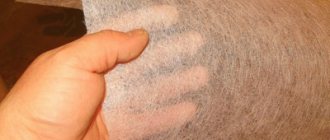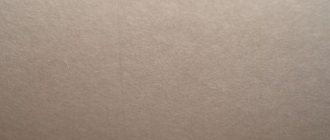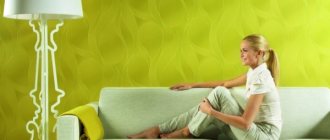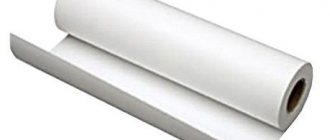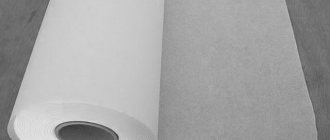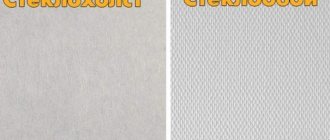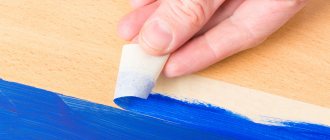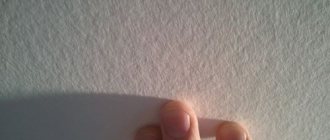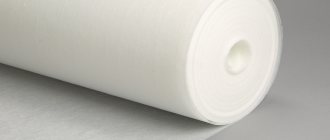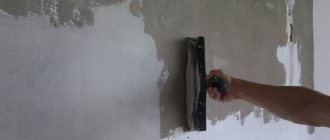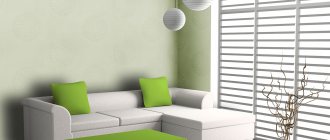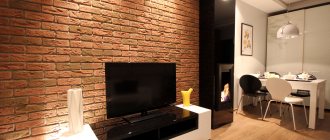Home / Types of ceilings / Wallpapered / We glue a “cobweb” to the ceiling
You can spend a lot of time, effort and money leveling the ceiling and at the same time, after some time, discover cracks in it. There can be many reasons - from violations of finishing technology to low-quality building materials. To avoid such troubles, many use the simplest method of protecting the surface - sticking cobwebs on the ceiling. What it is and how it is used, we will consider in this material.
Fiberglass for painting: innovative surface reinforcement technology
Any repair is not only labor-intensive, but also costly. Therefore, in order for the costs to be justified, special attention should be paid to high-quality finishing materials. One of the innovative developments in the construction industry is painting fiberglass . This material is used as a basis for surface finishing. This article provides information about what fiberglass canvas is for painting and what the technology for its installation is.
Paintable fiberglass is an innovative material for reinforcing walls and ceilings.
Fiberglass sticker
Before deciding whether it is possible to paint fiberglass and putty it before or not, the material needs to be glued to the wall. In this case, the surface to be glued needs to be prepared - leveled using putty, leaving cracks no more than 1 mm thick. You can refuse leveling only in cases where the wall is already quite smooth and strong.
The main nuances that arise during the preparatory work:
- wide cracks are sealed using a special compound for seams or regular putty, but in several steps;
- when using plasterboard sheets, the joints between them must be puttied and reinforced with self-adhesive fiberglass mesh (“serpyanka”); In order for the already pasted wall to be as smooth as possible, it is desirable that the seams between the drywall and the fiberglass sheets do not coincide with each other, otherwise cracks may appear in these places;
- dried “patches” on the wall need to be leveled using putty and sanded until the surface is almost perfectly flat;
- Before the fiberglass web for painting is glued to the wall, it should be cleaned of dust and thoroughly primed.
Due to the fact that the fiberglass gluing is done overlapping, when determining its area, you should take as the calculated value not only the surface of the walls, but also a small margin (at the level of 5–10%). And as an adhesive, it is advisable to use not ready-made, but dry glue, the characteristics of which are the same, and the price is much lower. During the work, special clothing is used - pants, long-sleeved shirts, gloves, a respirator and a hat. All this will help prevent fiberglass particles from getting on the skin and into the respiratory tract.
What is fiberglass for painting?
The first step is to understand what fiberglass is. The material is represented by a non-woven fabric, which is obtained from the smallest glass fibers using pressing technology. Due to its appearance in the form of a translucent thin product, it is called a painting web. This can be seen in the photo of fiberglass for painting. The threads are connected to each other in a chaotic manner using an adhesive composition based on organic resins. The main raw material for the material is quartz sand.
Fiberglass can also be used in various construction and repair areas.
Fiberglass is sold in rolls 1 m wide and 50 m long. The density of the material can vary between 25-50 g/m², which is selected depending on the plane of application of the material. For vertical surfaces you need to take fiberglass of a lower density, and for walls you should use a denser material.
The main purpose of the material is to prepare the base for finishing. The use of fiberglass makes it possible to eliminate the formation of cracks on the surface. It allows you to level the base without the use of global and labor-intensive work, such as plastering the ceiling and walls.
Its main function is to reinforce the surface. A surface prepared in this way will retain its attractive, original appearance for many years, eliminating the need to mask any cracks that have arisen. The material is fixed using an adhesive mixture, followed by painting or wallpapering. Fiberglass can be used for different substrates in rooms of any purpose.
The material is characterized by its versatility and wide range of use in various fields of construction. It can be used when making drainage holes, for organizing waterproofing, making wall panels and floor cladding, preparing mastics when creating roofing, and to increase the service life of metal pipes.
Painting fiberglass is a non-woven fabric consisting of glass microfibers.
What to do if a crack appears?
If a crack does appear, it can be easily fixed. A fiber patch is glued directly on top of the putty so that its width is at least 6 cm larger than the crack.
Then take a knife, apply good pressure and make a cut around the perimeter: through the patch, a layer of putty and the old canvas. Remove the layer of putty and glue the resulting patch to the exact size. Apply several layers of putty on top. If you want to extend the life of your finish, be sure to use such an inexpensive but very useful material as fiberglass. It is especially relevant for repairing cracks in plasterboard ceilings and boxes, which often crack at the seams. If you follow the technology for installing the structure and add to this the correct reinforcement of the joints, you will forever forget about microcracks.
Advantages and disadvantages of spider webs for painting
Fiberglass for wallpaper or painting is characterized by increased resistance to temperature changes. Substrate preparation can be carried out at temperatures from -40 to +60 °C, which will not affect the quality of the surface. The material is breathable and hygienic. Fiberglass does not attract or accumulate dust due to its antistatic properties. It eliminates the possibility of condensation forming on the surface, which is the cause of mold and mildew.
Gossamer fiberglass is characterized by hypoallergenicity, which is especially valuable for young children and people with allergies. They do not have a negative impact on human health, which is due to their environmental friendliness.
One of the significant advantages of the material is its fire resistance. It is impossible not to highlight the high wear-resistant qualities, due to which the base will retain its original appearance for a long time, which eliminates the need for frequent repairs. This surface can be painted several times. Fiberglass has an affordable price, as a result of which repairs can be performed efficiently and inexpensively.
Despite the large number of positive factors, fiberglass has quite serious disadvantages. It is necessary to work with the material with extreme caution, since small fragments of glass may break off when laying it. This can cause harm to health.
Cobwebs for painting are characterized by hypoallergenicity and resistance to temperature changes.
When glass fragments come into contact with the skin, they cause skin itching. A more serious consequence that will require seeing a doctor is the elements getting into the respiratory and visual organs. Therefore, it is necessary to work in closed clothing, gloves, a respirator and safety glasses.
Advantages
- has fire-fighting characteristics;
- environmentally friendly, since only components of natural origin are used for its production;
- durability and high strength;
- economically feasible material;
- the surface “breathes”, so there can be no fungus or mold on the surface;
- does not accumulate static.
Surface preparation
To begin with, the surface must be well cleaned of old coatings, and defects in the form of cracks and holes must be removed. You can look at additional photos to understand how the prepared surface should look.
For this purpose, starting putty is used. If the surface does not allow it, the use of cement-sand mortar is permissible. Small cracks can be repaired using putty and sickle mesh.
Then you need to putty the entire surface. Next comes the cleaning stage using sandpaper or a special mesh. If something needs to be trimmed, the putty is reused and then cleaned up again. Next, the surface must be primed. This will improve the interaction between materials.
Glue
Another option is to immediately buy branded glue.
To decorate the ceiling with high quality, you should select high-strength material. Reviews also confirm this. Fiberglass is often used for covering areas with high traffic. Such fiberglass wallpaper is wear-resistant, so it is used for further puttying or painting.
Process
Pasting is carried out at room temperature (from 18 to 25 degrees) and standard humidity (up to 75 percent). Drafts are not allowed. Do not forget that the fiberglass is facing the inside of the roll, which should be taken into account when performing work.
Pasting should be done by two people: one holds the canvas, and the other smoothes the material over the surface. Glue the fiberglass only when the primer is completely dry.
The canvas is cut with a margin so that the texture can be adjusted. Pasting begins on the side opposite the door.
Using a level, draw a line on the surface to ensure even gluing.
The glue is applied exclusively to the ceiling; this should not be applied to the canvas.
The canvas is pressed tightly to the surface. Using a tool, you need to get rid of any remaining air between the surfaces. And then, using a rubber roller, you need to carefully go over the joints so that they stick better. After all, the edges often dry the fastest, so the risk of material falling off is higher.
Fiberglass is glued end to end.
When the entire ceiling is pasted over, the wallpaper is covered with a layer of glue. This will allow you to get a more even color in the future, since otherwise the fiberglass will absorb a lot of paint, which will result in uneven color.
Like gluing, drying should occur at room temperature, without drafts or excess moisture. In this case, forced drying is unacceptable.
It is possible to apply glass wallpaper and overlap, but then you need to use a level and a sharp knife to cut through the middle of the overlap. Next, the remaining wallpaper is removed, and the joint is pressed with a rubber roller.
Conclusion
There is nothing difficult about gluing fiberglass yourself. In addition, you can familiarize yourself with video and photo materials, read reviews and recommendations from those who have already had such experience. Then the probability of a positive outcome will be highest. Moreover, the result will please you with its quality and durability.
Types of fiberglass for ceilings and walls
There are three main types of fiberglass used in construction. The first option, often called ceiling web, has a density of 25 g/m². The weight of 1 m² of material is only 25 g. The use of fiberglass is justified for ceilings for painting, since fiberglass is light in weight, making it convenient to glue.
The distinctive advantages of the material also include the low consumption of paint, which will be needed for the finishing coating. However, low-density fiberglass can be used for surfaces that do not have large cracks or irregularities.
A universal web is considered to be fiberglass with a density of 40 g/m², the strength of which is twice that of the previous option, but it has a lower cost than thicker analogues. This material is used for surfaces that are more subject to mechanical stress, which is more typical for walls. However, it can also be glued to a ceiling that is finished with old plaster. Such fiberglass is also suitable for finishing wall and ceiling coverings in rooms that experience high vibration loads.
Fiberglass canvases for painting have different levels of density.
One of the most durable options is fiberglass with a density of 50 g/m². The material is capable of sealing large cracks. It can withstand significant mechanical loads, so it is advisable to use such a web when decorating industrial premises, workshops, and garages, where there is a high probability of damage to fencing structures. The cost of installing such material is much higher than the cost of gluing previous analogues, which is associated with the large weight of the products and the significant consumption of glue for the web.
Note! High-strength fiberglass is not recommended for use in apartments and residential buildings.
Use to strengthen the ceiling
Fiberglass is used as a reinforcing element when additional strengthening of surfaces is necessary.
The fiberglass sticker on the ceiling is carried out in the following order:
- remove the old finish, level, putty and prime the ceiling;
- measure and cut pieces of suitable size from the canvas, leaving a small margin;
- fiberglass is glued to the ceiling end-to-end or at a short distance of the elements from each other;
- smooth the material from the center to the edges with a plastic spatula;
- After the entire surface of the ceiling is covered with cobwebs, its excess edges along the walls are carefully trimmed with a stationery knife.
After 24 hours, the surface will be completely dry, and you can proceed to further finishing.
Characteristics of glass insulation: rolled material based on fiberglass
For roofing work, Technonikol fiberglass has proven itself well, on the surface of which a highly oxidized bitumen composition with mineral additives is applied. A polymer film or coarse dusting can be used as a protective coating.
The material is characterized by biological stability, resistance to ultraviolet rays and temperature changes, environmental safety, high insulating qualities, sound absorption, low thermal conductivity, strength, flexibility, elasticity, ease of installation and durability.
Stekloizol is characterized by strength and low thermal conductivity.
Stekloizol is available in several varieties. The HPP material is characterized by low tensile strength. There is a specialized film on the fiberglass. This lining provides reliable protection of the base from moisture. The material can also be used as a waterproofing material for pipelines and underground structures.
TPP roll material is characterized by high tensile strength and increased resistance to significant mechanical loads. There is a low-melting polymer film on both sides of the canvas, which eliminates the possibility of material sticking together during transportation and storage. This type of glass insulation is also used as a substrate for roofing.
HKP fiberglass has a protective coating in the form of coarse shale chips, on top of which a protective polymer shell is applied. This material is intended for the installation of the top layer of the roof.
Note! HKP fiberglass is used for flat surfaces with a slight slope.
Stekloizol is an indispensable material for roofing work.
The most durable fabric is TKP fiberglass, the basis of which is frame fiberglass with coarse shale granulate and a protective polymer film applied on top. This material is used for arranging roofs with a slope of up to 10°.
Types of leakage
Water is flowing from the ceiling - substitute containers and save the floor and furniture!
A ceiling leak in an apartment can have several types.
- Neighbors upstairs are the most common cause of flooding. Typically, a leak is caused by a broken pipe or a forgotten faucet in the bathroom.
- Showers. The ceiling leaks during or after rain.
- Snow. The leak appears in the spring, when the snow melts.
- Dry leakage - occurs in hot weather due to the formation of condensation.
- A flickering leak does not always appear. The exact reason is unknown. It can be caused by microcracks or wind blowing precipitation under the roof, or by poor parapet design.
Causes
Often, if the roof damage is old, it is difficult to determine the exact cause.
However, there are several factors that contribute to leakage.
- The roofing material has expired.
- Mechanical damage during work (clearing snow, leaves, electrical installation work).
- Violation of technology during construction.
- Exposure to moisture and sunlight.
- Bending of metal sheets by the wind and their tearing off.
- High or low temperatures lead to a decrease in quality and loss of material properties.
Well-known manufacturers of painting fiberglass webs
To select a quality material, you should pay attention to fiberglass fabrics made by well-known manufacturers. The companies Wellton, Spektrum, Oskar, Samtex have proven themselves well. Depending on the density of the material, the price of fiberglass for painting will be 800-1500 rubles. per roll.
The Swedish manufacturer Oskar offers high-quality products that are characterized by good wear resistance and affordable prices. You can tear or cut the web only on purpose, with a sharp object. To paint such Oscar fiberglass, you will need a minimal amount of paint, even when painting without using putty. You can buy Oskar fiberglass from 1200 rubles. per roll.
Samtex's reinforcing material is in demand for protecting surfaces from cracks. The web is durable, hypoallergenic, wear-resistant and has good energy-saving properties. You can buy such a universal material for decorating walls and ceilings from 800 rubles. per roll.
Fiberglass from the Oskar company can be purchased from 1200 rubles. for one roll.
When performing painting, repair and construction work, fiberglass from the Finnish company Wellton is very popular. The web is characterized by increased fire safety, resistance to humidity, high temperatures and aggressive environments, high density, hypoallergenicity and a long period of operation. The cost of the material is 1000-1200 rubles. per roll.
The Dutch company Spektrum specializes in the production of high-quality fiberglass at an affordable cost. The material can be applied to any surface. A special place in the product range is given to dense fiberglass mats, which provide reliable protection of the wall surface from the formation of cracks and other damage. The price of fiberglass starts from 600 rubles. per roll.
Rules for using fiberglass products - what kind of glue is needed?
When performing construction work, it is always taken into account that there are concepts of starting finishing and finishing. First, rough work is carried out - cracks are sealed, surfaces are leveled. Such operations are called starting finishing. And only after this the finishing process is performed. Start-up work requires considerable qualifications from the contractor and significant financial costs. Fiberglass was created precisely in order to minimize labor, time, and monetary costs for rough finishing. Cobwebs on the walls and ceiling give these bases maximum strength and strength.
Gluing fiberglass
Experts recommend that you always use fiberglass when roughing wall surfaces that are constantly exposed to mechanical stress and stress. The web will make them even and reduce the likelihood of cracks. Please note that it is allowed to glue fiberglass to plasterboard (gypsum plasterboard). The described fiberglass material in this case makes it possible to hide and strengthen the most problematic elements of surfaces made of plasterboard sheets - the seams.
The web should be glued for painting using special compounds that are used for attaching glass wallpaper. The adhesives we are interested in include special antifungal additives and are manufactured using special formulas. It is easy to find suitable glue for spider webs in construction stores. It is usually a dry mixture. It must be diluted in specified proportions with water and then used for its intended purpose. The required amount of liquid and mixture is indicated by the manufacturer in the instructions for the adhesive composition. The most popular dry mixes are Bostik, Wellton, Oscar, Pufas. They are characterized by the absence of harmful fumes during use and high strength and efficiency.
How to glue fiberglass: algorithm for performing the work
Before gluing fiberglass for painting, it is necessary to ensure optimal working conditions. The walls should be inspected for visible defects in the form of cracks, potholes and other defects. They must be removed using a plaster mixture or putty. Next, the base is treated with a special primer, which must have good penetrating ability. This mixture helps to level the surface structure, bind dust and fill microcracks.
Note! Gluing fiberglass to the surface of a wall or ceiling is carried out at a temperature of 15-25 ° C, relative humidity no higher than 60%, excluding drafts and direct sunlight.
Before gluing fiberglass, the surface must be primed.
After applying the primer, it is necessary to allow time for it to dry completely. This is very important, since a fine crystal lattice with high adhesion is formed. This film will be damaged if you do not wait for the base to dry.
Before gluing fiberglass to a ceiling or wall, you need to prepare the material. It is very inconvenient to work with long solid panels. They are cut into elements convenient for work. In this case, allowances (1-2 cm) along the edges should be observed. Next, the glue is prepared. It is applied to the back side of the strip of material along the width and sides, spreading it in a thin layer - 1-1.5 mm.
Note! Material consumption is 10 g per 1 m² of web.
How to use
The main use of this fabric was to seal cracks and paste various surfaces to prevent their occurrence. Cobweb, as such fiberglass is popularly called, can protect even very “restless” planes from cracking. In old houses with crumbling plaster, such measures to protect the ceiling from cracks are very important.
To use the web, you don’t need any sophisticated equipment or special skills to work with it. All you need is some glue and a little persistence. If you have glued wallpaper at least once, then you can handle cobwebs.
After gluing the surface, it can be leveled with putty or immediately painted. If you simply paint a plane covered with such fiberglass, it will acquire the desired color, while maintaining the characteristic texture and pattern of the web.
Fiberglass for painting: installation technology
When performing work, it is important to consider how to properly glue fiberglass. The process starts from the angle of the plane. This could be a wall or ceiling. After gluing the first strip, the second element is fixed overlapping, which is subsequently trimmed. The pile on the material should face one direction. Otherwise, the surface after painting will be unaesthetic. This is how the remaining parts of the finish are installed.
Before gluing the web, you need to wait until the surface is completely dry.
The price of gluing fiberglass depends on the surface of the finish. The cost of covering the ceiling will be slightly higher compared to the price of covering the wall.
When gluing fiberglass to plasterboard, the material should be positioned so that its butt joints do not coincide with the seams between the plasterboard sheets. To eliminate such a situation, it is necessary to first mark the base.
An important step is the careful joining of adjacent strips. The joints should be additionally impregnated with glue and pressed well with a spatula. The finished finish must dry completely, which will take 2 days. You can glue the material yourself or invite a specialist to finish the surface with fiberglass. The price per m2 starts from 150 rubles.
On a note! For a more reliable fixation of the fiberglass, it is recommended to additionally coat the top surface with liquid glue.
For ease of installation, fiberglass is cut into separate sheets, taking into account the allowance.
Final stage
When complete drying occurs, and this can take up to two days, you can begin to putty the surface. If painting is intended, it is better to use finely dispersed putty. It should be applied in several layers. Each layer must be allowed to dry completely. After this, you can begin sanding using sandpaper. We must not forget that, as with simple painting, you must first prime the walls or ceiling.
Nowadays, they are increasingly skipping the puttying stage. This is replaced by applying a generous layer of glue. With this trick you can reduce paint consumption. Just keep in mind that in this case the mesh structure of the web will be noticeable. This will be impossible to change even if you apply many layers of paint. You won't get a smooth surface.
Fiberglass has many advantages, but there are also some minor disadvantages to consider. When cutting the mesh, small particles of fiberglass appear. When they get on open areas of the body, mucous membranes, they cause severe irritation. Therefore, work is carried out exclusively in special clothing and respirators.
But such minor shortcomings cannot cancel out the advantages that fiberglass web has. Its use allows you to avoid many unpleasant moments in the future. In addition, its pasting does not require special skills.
What to glue fiberglass on: choosing the right composition
For gluing to the surface of fiberglass, two types of glue can be used: dry powder and ready-made mixture. It is important to choose formulations designed specifically for this material. Wallpaper glue will not work. This is due to the fact that fiberglass is heavier than paper, so a regular composition may not withstand such weight. In addition, fiberglass fabric has a structure consisting of woven fibers that wallpaper glue will not connect.
The adhesive composition for fiberglass for painting on a ceiling or wall includes high-quality components that do not have a negative effect on the human body. This glue is characterized by antifungal properties.
When purchasing ready-made glue, it is mandatory to check the date of manufacture of the composition. An expired product will not provide the desired result. The surface may swell, which will lead to peeling of the fabric. Opened containers must be used up as soon as possible. Therefore, when purchasing a ready-made composition, you should focus on the surface area and the consumption of material required to fill it. The cost of the finished mixture is in the range of 450-600 rubles. for 10 kg.
Dry mixtures or ready-made glue are suitable for fixing fiberglass.
On a note! The rate of material consumption is indicated on the plastic container.
Criteria for choosing glass wallpaper
To avoid making mistakes when choosing, you should consider several basic parameters:
- density value;
- features of the pattern;
- description of the composition;
- packaging quality;
- who is the manufacturer.
Each of the criteria deserves detailed consideration.
Density
A parameter that serves as an indicator of strength and durability. The dependence on density is directly proportional - the denser, the stronger, more durable, and can withstand more layers of paint. Canvases with a density of 100 g/cm2 or more are considered high-quality. They are also the most expensive. Less dense coatings (up to 100 g/cm2) may not last up to 30 years of operation and are inferior in strength to high-quality ones. But they are cheaper.
Patterns
The main types of drawings have already been listed:
- matting;
- Christmas trees;
- diamonds;
- raindrops on glass;
- parquet;
- rice paper.
The choice is small. True, manufacturers do not stop there, and from time to time they develop new designs, so you can always choose an interesting option for decorating an apartment. Particular attention should be paid to the depth of the pattern relief. The larger it is, the more layers of paint can be applied to the fabric in the future, preserving the design.
Composition of fiberglass and packaging of rolls
A very important parameter. A quality product should consist of 70% glass. The remaining 30% comes from impregnation. This is the ideal composition and information about it should be present in the accompanying documentation. Deviations from this ratio, as well as a complete lack of information about the composition, should alert the buyer.
To prevent the user from confusing the front side with the back side when sticking wallpaper, the manufacturer applies special marks to the back of the canvas. The fabric should not have weaving defects. The edges of a quality product are always cut evenly and should not crumble. You should also pay special attention to this when purchasing.
What fiberglass is glued to: other composition options
Glue in the form of a dry powder is more profitable to use. The finished composition can be prepared in the required volume. The powder should be diluted with warm water, which is carried out in accordance with the instructions. The dry composition can be bought for 400-450 rubles. for 0.5 kg.
On a note! According to reviews, it is better to paste fiberglass for painting with mixtures of recognized brands Wellton, Oskar, Pufas and Bostik.
Fiberglass can be glued using PVA glue. However, it should be borne in mind that the material has a low density, so it transmits a large amount of ultraviolet radiation. After some time, the glue will turn yellow, which will affect the decorative effect of the final coating. Therefore, when gluing fiberglass to PVA glue, paint should be chosen in dark shades.
Experts recommend using only special glue for fiberglass for gluing.
You can make glue yourself. Before gluing the canvas with gelatin, prepare a composition at the rate of 25 g of the substance per 350 ml of water. After the gelatin has been soaked for 1 hour, add ½ tablet of crushed aspirin and 1 tsp. glycerin or castor oil. The mixture is heated to a temperature of 40-45 °C and removed from the heat. When the glue cools, it will have the consistency of a medium soft jelly.
Technology of the canvas gluing process
Expanded polystyrene 30 mm
First you need to clean the ceiling from old plaster to the concrete base. If surface defects are found, correct them using putty. Then it should be primed using a deep penetration primer. After drying, the ceiling is puttied in two stages to level the surface. Fiberglass for puttying a plasterboard ceiling?
The first layer with a coarse-grained structure levels, and the second, fine-grained, polishes. Both layers must dry well for further processing. Afterwards, the surface is sanded with sandpaper and treated again with a primer.
Gluing fiberglass to the ceiling begins with diluting the glue. There are a lot of special adhesive suspensions on sale; it is acceptable to use PVA-based products. The glue is sold in liquid and dry form.
It is more economical to use the second option, the main thing is to follow the instructions for diluting the powder.
It is advisable to prepare strips of canvas in advance; they are cut to length according to the size of the room with an allowance of 5-10 cm for alignment. You should only cut the canvas with sharp scissors to avoid fraying of the edges.
Before pasting, do not forget to create the following conditions:
- optimal temperature is from 18 to 25 degrees Celsius;
- eliminate the possibility of drafts;
- Do not allow sunlight to hit the surface of the canvas while working.
You can start gluing the surface from the center or corner of the room. If gluing is done from the center, then it is necessary to draw a line. You will start from this straight line during the work process.
The strips are glued end to end, the excess length is immediately removed. When pruning, be extremely careful, as you can damage the wet canvas. If there is an uneven edge on the roll, you can glue it with an overlap, but you should immediately remove the unevenness with a sharp cutting tool.
The entire plane is covered in this way, and at the end it is completely treated with glue. After this procedure, the ceiling dries for about a day. The pasted canvas will protect the surface from various damages for a long time.
Characteristics of Oscar glue for fiberglass
According to numerous reviews, it is better to glue fiberglass with Oskar, a water-dispersed acrylic adhesive that contains PVA, latex, modified starch and antiseptic additives. The glue can be presented in the form of a dry powder, which is easily diluted with cold water without forming lumps, or a ready-made composition.
The finished mixture is frost-resistant, so it can be stored at a temperature of 50 ° C for 1 month. After the 5th defrosting, the composition will not be suitable for use. Ready-made glue is produced in buckets with a capacity of 5 and 10 liters. Stored unopened for up to 3 years. You can buy glue for Oskar fiberglass from 500 rubles. The dry composition is stored for up to 2 months. It is produced in bags of 1 and 10 kg, cardboard packages weighing 200 and 400 g. The cost of the smallest packaging is about 200 rubles.
The product is applied to the surface to be decorated. Thanks to the elastic base, the position of the canvas can be easily adjusted until the glue dries. The mixture contains antiseptic additives that prevent the formation of mold, mildew and pathogens. The composition is environmentally friendly. It has no odor, is a non-flammable, non-flammable, explosion-proof mixture. The glue has good breathability.
Oskar fiberglass adhesive has many positive reviews.
The composition is characterized by economical consumption, which is 350 g per 1 m² of fiberglass. After complete drying, Oskar glue becomes completely transparent. It provides high bond strength due to good adhesive properties. You can stick high-density fiberglass on it, which will not sag or fall off over time.
Note! Oskar glue can be used not only for painting fiberglass, but also for paper, non-woven and fiberglass wallpaper.
Where to buy glass wallpaper
Of course, it is better to buy building materials in specialized stores. Here you can look and touch the product, evaluate whether there are any defects, whether the edges are cut smoothly, and see with your own eyes the texture of the canvas and its color (if you are purchasing an already tinted product). If this is not possible, all you have to do is order the product online in an online store. Some of them can be found on the Yandex Market pages. There you can also find a description of the product, navigate by price and choose a store by studying reviews of customers who have used its services. If everything is satisfactory, you can place your order and delivery here.
Preparing fiberglass for painting: important recommendations
Deciding on the need to putty the surface causes some disagreement among craftsmen. The web has a beautiful structure, which many people want to preserve, but in this case the paint consumption will be significant, since it will be necessary to paint the fiberglass without putty in 4-5 layers. In addition, joints will be noticeable on the surface, no matter how perfectly they are made.
Another reason why it is necessary to putty fiberglass is the likelihood of tiny particles of glass entering the air that are harmful to human health. A layer of plaster will completely eliminate this drawback.
Whether or not to putty a surface with fiberglass is up to everyone to decide for themselves.
To putty the surface of fiberglass, use any good quality finishing mixture on a polymer or gypsum basis. The composition is applied after the surface has completely dried. The putty should be applied in two layers with a break of 24 hours. The first layer must have a thickness of no more than 2 mm, the second must completely cover the initial base. After drying, the surface is rubbed with sandpaper to give it a smooth structure. Before painting or wallpapering, the web must be re-primed and the surface must be completely dry.
Application for decorative finishing
Fiberglass can be painted or coated with other materials only after it has completely dried. If the paint is applied directly to the fiberglass, the web structure will show through the finish. But this technique will give the surface an original look.
To obtain a perfectly flat base, you will need to first level the fiberglass with a layer of putty.
Typically, dry mixtures are used for work, which are stirred in water until the desired consistency is obtained. Apply the composition in a thin layer, not exceeding 1.5-2 mm, using a spatula.
Next, the surface is grouted, but before that you need to make sure that the material is completely dry. The work is carried out with a special grater or grinding machine, where abrasive paper is attached.
Important! If two or more layers of putty are to be applied, each layer must dry well. Moreover, the next layer must be applied to the surface no earlier than 12 hours after applying the previous one.
Painting fiberglass on ceilings and walls
Painting cobwebs is carried out according to the same principle as painting any other surface. Before painting fiberglass, you should choose a paint. To do this, you can use a water-based acrylic, silicone or latex mixture.
Latex paint is the most popular because it is characterized by numerous advantages. It is easily and quickly applied to the base, forming a durable, abrasion- and water-resistant surface that will have an attractive matte appearance. The paint is sold primarily in white, but can be tinted to any tone. The latex composition has an affordable price.
Latex paint is made on a water-dispersion basis, without the use of chemical components. Therefore, this material is best suited for children's rooms. The paint contains natural latex, thanks to which the final coating will be resistant to water and durable. Using an acrylic product, it is possible to obtain a glossy, matte and semi-gloss surface.
Silicone, latex and acrylic paint are suitable for painting fiberglass.
Silicone paints are also environmentally friendly because they do not contain harmful components. Thanks to such compositions, the surface is vapor-permeable, waterproof, heat-resistant, and is not exposed to fungus, mold and ultraviolet radiation. The coating does not get dirty and can retain its original gloss for more than 15 years. The main disadvantage of this paint is its high cost.
Fiberglass is painted in two layers. However, between their application an interval should be maintained until the surface is completely dry. Otherwise, the paint will warp and may peel off after some time in layers, exposing the fiberglass.
For high-quality surface painting, use a lint roller. It is better not to use a foam analogue, as it can crumble into pieces. You also need a brush for painting corners and joints.
Fiberglass for puttying and painting is a modern material that solves many problems when finishing surfaces. It not only acts as a protective coating for the base, extending its service life, but is also a decorative layer that is used for painting.
The best manufacturers
The quality of products directly depends on the manufacturer. The best companies, which have been working in this market segment for many years, have proven themselves to be of consistently high quality products, constant innovation, and expansion of the range. Some of them are worth getting to know better.
- Tassoglas
American brand product. Production facilities are deployed in China, Europe and the USA. The sale of goods is carried out with the obligatory attachment of a quality certificate confirming environmental friendliness, fire and sanitary safety. Practical and high-quality canvas is ideal not only for covering the walls and ceilings of living rooms, but also for renovating various offices and institutions.
- Nortex
Russian brand with production facilities in China. Premium class products are distinguished by high quality and increased density, up to 200 g/m2, with a warranty period of more than 30 years. The density of economy class wallpaper does not exceed 100 g/m2 and is more affordable. As an original and durable decor, they are suitable for finishing different rooms.
- Vitrulan
The owner of the trademark is a German company – a leading manufacturer of fiberglass wallpaper in Europe. It all started with a small glass factory in the city of Haselbach in 1896. Already in 1921 the company produced glass fiber and glass wool. In 1929 the company became Vitrulan.
Interesting! The company name comes from the Latin words Vitru - glass and lan - fiber.
In 1931, the company first produced fiberglass wall coverings in various colors. Today, Vitrulan Textile GMbH specialists conduct constant scientific research in order to improve the consumer qualities of their products. At his request, the client can order a coating with specified properties: smoothness, softness, hardness and color, chemical fire resistance.
- Wellton
The world-famous Swedish brand has been producing wall coverings of high quality and stylish design for many years. Production is established at factories in Sweden, Germany, Russia, the Czech Republic and China.
- Oscar
Wellton's subsidiary produces its popular and inexpensive models in China. Product quality is high, prices are more affordable.
- X – Glass
Russian brand with production in Russia and Finland. Produces high-quality canvas and fiberglass in the middle price segment. The assortment is quite wide.
- Brattendorf
The brand is from Germany and belongs to the relatively young company Preiss Daimler group Industriegesellschaft GmbH Glasfaser Brattendorf (Haglasta). The high quality of the product allows it to be used not only in any residential premises, but also in hospitals and cancer centers, schools, kindergartens, museums and pharmacies. On the Russian market, the product is supplied under the Brattendorf brand, in EU countries it is known as Haglasta. The popularity of fiberglass wallpaper models from this brand is explained by their high quality
- Saint-Gobain Novelio
Joint Franco-Czech production with the involvement of Italian designers led to the appearance of high-quality colored glass wallpaper on the market. The collection includes several textured and more than twenty color solutions. Saint-Gobain Novelio coatings are widely used for finishing walls and ceilings in hotels and spa centers, and other elegant and expensive interiors.
- Erfurt
The German company has been producing wallpaper since 1827. It gained worldwide fame by producing high-quality paper wallpaper Rauhfaser, which is incredibly popular today. Erfurt fiberglass coverings are a guarantee of quality and durability.
The list of the best manufacturers can be continued for quite a long time. It is impossible to immediately say which company is better to buy a product from. This depends on the type of work (preparing walls for finishing or finishing), the category of the room, its fire hazard, etc. In any case, it is worth asking professionals how to choose the right product, listen to the advice and recommendations of the store seller, read the description and clarify the characteristics , find out how much the selected product costs and make an informed decision.
